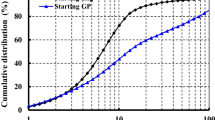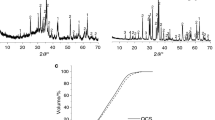Abstract
Alkali-activated slag (AAS) cement is one type of alkali-activated binders free from Portland cement. The main problems of this type of cement are its high drying shrinkage and low carbonation resistance that hinder its wide use. In the current paper, the authors tried to suppress this high drying shrinkage and enhance the carbonation resistance of this type of binder by incorporating quartz powder (QP). For that reason, slag was partially replaced with QP at ratios of 10–30 wt%. The flowability of each mixture was measured using a hand-driven flow table. The initial reading of drying shrinkage was monitored after 24 h from casting and continued up to 90 days. After initial curing, some specimens were exposed to atmospheric natural carbonation for one year, whilst the remaining specimens were sealed and used as references. Different techniques such as thermogravimetric analysis and its derivative (TGA/DTG), Fourier transform infrared (FTIR) spectroscopy, and scanning electron microscopy (SEM) were used to analyze the results. The results showed that the incorporation of QP in the matrix increased the flowability and compressive strength, decreased the drying shrinkage, increased the carbonation resistance, and refined the microstructure.












Similar content being viewed by others
Data availability
Not applicable.
References
Abdel-Gawwad H, Heikal M, Mohammed MS, Abd El-Aleem S, Hassan HS, García SV, Rashad AM (2019) Evaluating the impact of nano-magnesium calcite waste on the performance of cement mortar in normal and sulfate-rich media. Constr Build Mater 203:392–400
Abdollahnejad, Z., Mastali, M., Woof, B. & Illikainen, M. (2020) High strength fiber reinforced one-part alkali activated slag/fly ash binders with ceramic aggregates: microscopic analysis, mechanical properties, drying shrinkage, and freeze-thaw resistance. Construction and building materials 241:118129.
Akturk, B. & Kizilkanat, A. B. (2020) Improvement of durability and drying shrinkage of sodium carbonate activated slag through the incorporation of calcium hydroxide and sodium hydroxide. Construction and building materials 243:118260.
Andrew RM (2018) Global CO2 emissions from cement production. Earth System Science Data 10(1):195
Astmc305–06 (2011)Standard practice for mechanical mixing of hydraulic cement pastes and mortars of plastic consistency, ASTM International.
Atiş CD, Bilim C, Çelik Ö, Karahan O (2009) Influence of activator on the strength and drying shrinkage of alkali-activated slag mortar. Constr Build Mater 23(1):548–555
Aydın S (2013) A ternary optimisation of mineral additives of alkali activated cement mortars. Constr Build Mater 43:131–138
Bakharev T, Sanjayan J, Cheng Y-B (2001) Resistance of alkali-activated slag concrete to carbonation. Cem Concr Res 31(9):1277–1283
Behfarnia K, Rostami M (2017) An assessment on parameters affecting the carbonation of alkali-activated slag concrete. J Clean Prod 157:1–9
Bernal SA, Provis JL, De Gutiérrez RM, Van Deventer JS (2015) Accelerated carbonation testing of alkali-activated slag/metakaolin blended concretes: effect of exposure conditions. Mater Struct 48(3):653–669
Bernal SA, Provis JL, Walkley B, San Nicolas R, Gehman JD, Brice DG, Kilcullen AR, Duxson P, Van Deventer JS (2013) Gel nanostructure in alkali-activated binders based on slag and fly ash, and effects of accelerated carbonation. Cem Concr Res 53:127–144
Bilim C, Atiş CD (2012) Alkali activation of mortars containing different replacement levels of ground granulated blast furnace slag. Constr Build Mater 28(1):708–712
Cadore D, Da Luz CA, De Medeiros MF (2019) An investigation of the carbonation of alkaline activated cement made from blast furnace slag generated by charcoal. Constr Build Mater 226:117–125
Cherkaoui, K., Courtial, M., Dunstetter, F., Khelidj, A., Mounanga, P. & De Noirfontaine, M.-N. (2010) Early-age volume changes of extrudable reactive powder concrete. In EPJ Web of Conferences.) EDP Sciences, vol. 6, pp. 23005.
Chi, M.-C., Chang, J.-J. & Huang, R. (2012) Strength and drying shrinkage of alkali-activated slag paste and mortar. Advances in Civil Engineering 2012.
Collins F, Sanjayan JG (1999) Workability and mechanical properties of alkali activated slag concrete. Cem Concr Res 29(3):455–458
Dung, N., Hooper, T. & Unluer, C. (2020) Enhancing the performance of MgO-activated slag-fly ash mixes by accelerated carbonation. Journal of CO2 Utilization 42:101356.
Dung, N., Hooper, T. & Unluer, C. (2021) Improving the carbonation resistance of Na2CO3-activated slag mixes via the use of reactive MgO and nucleation seeding. Cement and Concrete Composites 115:103832.
Gharieb, M., Mosleh, Y. A. & Rashad, A. M. (2021) Properties and corrosion behaviour of applicable binary and ternary geopolymer blends. International Journal of Sustainable Engineering:1–13.
He J, Gao Q, Wu Y, He J, Pu X (2018) Study on improvement of carbonation resistance of alkali-activated slag concrete. Constr Build Mater 176:60–67
Huang G, Ji Y, Li J, Hou Z, Jin C (2018) Use of slaked lime and Portland cement to improve the resistance of MSWI bottom ash-GBFS geopolymer concrete against carbonation. Constr Build Mater 166:290–300
Jang J, Park S, Kim G, Lee H-K (2017) Stability of MgO-modified geopolymeric gel structure exposed to a CO2-rich environment. Constr Build Mater 151:178–185
Jia Z, Yang Y, Yang L, Zhang Y, Sun Z (2018) Hydration products, internal relative humidity and drying shrinkage of alkali activated slag mortar with expansion agents. Constr Build Mater 158:198–207
Lee H-S, Lim S-M, Wang X-Y (2019) Optimal mixture design of low-CO2 High-volume slag concrete considering climate change and CO2 uptake. International Journal of Concrete Structures and Materials 13(1):56
Lee, H. (2007) Intergovernmental Panel on Climate Change.
Lee NK, Koh KT, Kim MO, An GH, Ryu GS (2017) Physicochemical changes caused by reactive MgO in alkali-activated fly ash/slag blends under accelerated carbonation. Ceram Int 43(15):12490–12496
Li N, Farzadnia N, Shi C (2017) Microstructural changes in alkali-activated slag mortars induced by accelerated carbonation. Cem Concr Res 100:214–226
Liu, G., Florea, M. & Brouwers, H. (2021a) The role of recycled waste glass incorporation on the carbonation behaviour of sodium carbonate activated slag mortar. Journal of Cleaner Production 292:126050.
Liu, L., Xie, M., He, Y., Li, Y., Wei, A. & Shi, C. (2020) Expansion behavior and microstructure change of alkali-activated slag grouting material in carbonate environment. Construction and building materials 262:120593.
Liu, S., Hao, Y. & Ma, G. (2021b) Approaches to enhance the carbonation resistance of fly ash and slag based alkali-activated mortar-experimental evaluations. Journal of Cleaner Production 280:124321.
Ma J, Dietz J, Dehn F (2002) Ultra high performance self compacting concrete. Lacer 7:33–42
Mastali M, Kinnunen P, Dalvand A, Firouz RM, Illikainen M (2018) Drying shrinkage in alkali-activated binders–a critical review. Constr Build Mater 190:533–550
Neto A, a. M., Cincotto, M. A. & Repette, W. (2008) Drying and autogenous shrinkage of pastes and mortars with activated slag cement. Cem Concr Res 38(4):565–574
Pu X, Gan C, Wang S, Yang C (1988) Summary reports of research on alkali-activated slag cement and concrete. Chongqing Institute of Architecture and Engineering, Chongqing 1:6
Puertas F, Palacios M, Vázquez T (2006) Carbonation process of alkali-activated slag mortars. J Mater Sci 41(10):3071–3082
Rashad AM (2015) Influence of different additives on the properties of sodium sulfate activated slag. Constr Build Mater 79:379–389
Rashad AM (2018) Effect of quartz-powder on the properties of conventional cementitious materials and geopolymers. Mater Sci Technol 34(17):2043–2056
Rashad, A. M. & Essa, G. M. (2020) Effect of ceramic waste powder on alkali-activated slag pastes cured in hot weather after exposure to elevated temperature. Cement and Concrete Composites:103617.
Rashad AM, Hassan AA, Zeedan SR (2016) An investigation on alkali-activated Egyptian metakaolin pastes blended with quartz powder subjected to elevated temperatures. Appl Clay Sci 132:366–376
Rashad AM, Morsi W, Khafaga SA (2021) Effect of limestone powder on mechanical strength, durability and drying shrinkage of alkali-activated slag pastes. Innovative Infrastructure Solutions 6(2):1–12
Rashad AM, Ouda AS (2016) An investigation on alkali-activated fly ash pastes modified with quartz powder subjected to elevated temperatures. Constr Build Mater 122:417–425
Rashad AM, Ouda AS, Sadek DM (2018) Behavior of alkali-activated metakaolin pastes blended with quartz powder exposed to seawater attack. J Mater Civ Eng 30(8):04018159
Rashad, A. M. & Sadek, D. M. (2021) An exploratory study on alkali-activated slag blended with microsize metakaolin particles under the effect of seawater attack and tidal zone. Arabian Journal for Science and Engineering:1–12.
Rashad AM, Zeedan SR, Hassan HA (2012) A preliminary study of autoclaved alkali-activated slag blended with quartz powder. Constr Build Mater 33:70–77
Robayo-Salazar, R. A., Aguirre-Guerrero, A. M. & De Gutiérrez, R. M. (2020) Carbonation-induced corrosion of alkali-activated binary concrete based on natural volcanic pozzolan. Construction and building materials 232:117189.
Song, K.-I., Song, J.-K., Lee, B. Y. & Yang, K.-H. (2014) Carbonation characteristics of alkali-activated blast-furnace slag mortar. Advances in Materials Science and Engineering 2014.
Thomas R, Lezama D, Peethamparan S (2017) On drying shrinkage in alkali-activated concrete: improving dimensional stability by aging or heat-curing. Cem Concr Res 91:13–23
Wang L, Yang H, Dong Y, Chen E, Tang S (2018) Environmental evaluation, hydration, pore structure, volume deformation and abrasion resistance of low heat Portland (LHP) cement-based materials. J Clean Prod 203:540–558
Wang S-D, Scrivener KL (1995) Hydration products of alkali activated slag cement. Cem Concr Res 25(3):561–571
Yang, J., Wang, Q. & Zhou, Y. (2017) Influence of curing time on the drying shrinkage of concretes with different binders and water-to-binder ratios. Advances in Materials Science and Engineering 2017.
Zhang J, Shi C, Zhang Z (2019) Carbonation induced phase evolution in alkali-activated slag/fly ash cements: the effect of silicate modulus of activators. Constr Build Mater 223:566–582
Zhang J, Shi C, Zhang Z, Ou Z (2017) Durability of alkali-activated materials in aggressive environments: a review on recent studies. Constr Build Mater 152:598–613
Zhang, P., Gao, Z., Wang, J., Guo, J., Hu, S. & Ling, Y. (2020) Properties of fresh and hardened fly ash/slag based geopolymer concrete: a review. Journal of Cleaner Production:122389.
Author information
Authors and Affiliations
Contributions
Alaa M. Rashad: project administration, conceptualization, writing – original draft, writing – review and editing, methodology, investigation. Dina M. Sadek: writing – original draft, validation, visualization, investigation. Mahmoud Gharieb: writing – original draft, methodology, formal analysis, data curation, investigation.
Corresponding author
Ethics declarations
Ethics approval and consent to participate
Not applicable.
Consent for publication
Not applicable.
Conflict of interest
The authors declare no competing interests.
Additional information
Responsible Editor: Philippe Garrigues
Publisher's note
Springer Nature remains neutral with regard to jurisdictional claims in published maps and institutional affiliations.
Rights and permissions
About this article
Cite this article
Rashad, A.M., Sadek, D.M. & Gharieb, M. Valorization of quartz powder for drying shrinkage and carbonation resistance of alkali-activated slag cement. Environ Sci Pollut Res 29, 45191–45203 (2022). https://doi.org/10.1007/s11356-022-18951-3
Received:
Accepted:
Published:
Issue Date:
DOI: https://doi.org/10.1007/s11356-022-18951-3




